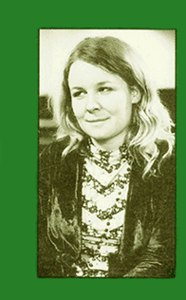
Booker T. and the MGs, Green Onions (live).
Larry Clinton, A Study in Green.
Can, I'm So Green.
Hildegard von Bingen, O Viridissima Virga.
Vera Lynn, How Green Was My Valley.
R.E.M., Green Grow the Rushes.
Louis Jordan, The Green Grass Grows All Around.
Rosemary Clooney, Mountain Greenery.
Bill Haley and the Comets, Green Tree Boogie.
New Order, Everything's Gone Green.
The Housemartins, The Light Is Always Green.
Porter Wagoner, Green, Green Grass of Home.
Creedence Clearwater Revival, Green River.
The Kinks, Village Green.
Sybille Baier, Colour Green.
Jim Lowe, Green Door.
Esquerita, Green Door.
Elvis Costello, Green Shirt.
Husker Du, Green Eyes.
Sugarloaf, Green-Eyed Lady.
Weems String Band, Greenback Dollar.
Ray Charles, Greenbacks.
John Coltrane, Greensleeves.
The dawn was apple-green,
The sky was green wine held up in the sun,
The moon was a golden petal between.
D.H. Lawrence, Green.
Green is the shade of life--it is nature's favored color, so much that nature, unchecked, would clothe the whole of the world in green, from emerald crabgrass to pine-tinged mountains. Green is excess, fecundity, spirit--it teems, it grows. It can seem too profuse, too unruly a color, especially to the more ascetic types--Piet Mondrian, for instance, came to violently hate green, exiling it from his later paintings, and even refusing to look out windows for fear of being "unexpectedly overwhelmed by Mother Nature's green" (Herman Pleij); Kandinsky believed green's ubiquity and general pleasantness marked it as the staid color of the bourgeoisie, and green is scarce in heraldry, indicating some elite families thought the same.
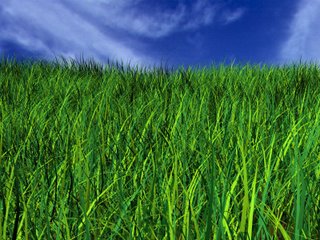
Green is insperable from the act of growth--the English word 'green' (and the German 'grun') is ultimately derived from the Old English growan, 'to grow'. It is the first color mentioned in the Peshitta Bible (compare and contrast Genesis here). The Peshitta Genesis 1:11: "And God said let the earth bring forth green plants." The Hebrew Bible introduces green a bit later, in Genesis 30, in which God gives the animals "all the green plants" to eat.
It is a zesty, deep color. Because of its unchecked supremacy in nature, it still surprises to realize green is only a secondary color, in which yellow's heart is ennobled by blue's grace. (Though green is one of the primary colors of television and computer monitors, having supplanted its parent yellow.)
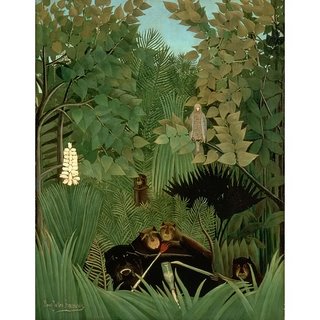
Rousseau, Joyeux Farceurs, 1906.
Profuse on earth, deliberate in music. Green, according to Scriabin, is the counterpart of A major, not the most popular of keys (though one Christian Schubart said suggests "declarations of innocent love...hope of seeing one's beloved again when parting; youthful cheerfulness and trust in God.") To me, green is the sound of funk and soul--of the thick texture of rolling bass lines, the solid backbeat, funky organs and synclaviers, chicken-scratch guitar--it is the color of the groove.
Don't take my word for it. State's evidence no. 1--"Green Onions" by Booker T. and the MGs. This live recording, from the 5/4 Ballroom in Los Angeles in August 1965, is the goods. Booker T.'s organ playing is like a graduate seminar on soul, and Steve Cropper's guitar, especially his amazing 36-bar solo, is ridiculous. Duck Dunn and Al Jackson keep it all together. Less than a week after this concert, the Watts riots began. Find this version is on Stax Profiles or on Funky Broadway.
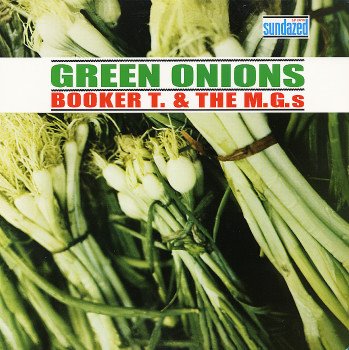
A lighter groove, but still suitable for dancing, can be found in Larry Clinton's "Study in Green," from 1938. On Studies in Clinton.
And Can's "I'm So Green", German progressive rock madness at its finest, is on 1972's Ege Bamyasi.
Green myriads
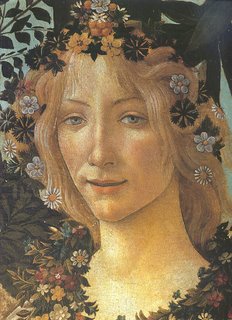
Botticelli, Primavera (detail), 1482.
Mark how it mounts to man's imperial race
From the green myriads in the peopled grass...
of smell, the headlong lioness between
and hound sagacious on the tainted green:
Of hearing, from the life that fills the flood
to that which warbles thro' the vernal wood.
Pope, Essay on Man, Epistle I.
Green is the tone of health, of the planet's drapery, nowhere better displayed than verdant-hued Puerto Rico or Ireland ("the greenest place I've never seen," wrote Marianne Moore). It's no surprise how many songs have come about in praise of the color as nature's ambassador, and in some cases as God's.
Let's begin with Hildegard von Bingen, the 12th Century composer, scientist, botanist, healer, etc., who centers one hymn of praise to the Virgin Mary around the joy of viriditas (greenness)--O Virdissima Virga. Elsewhere, von Bingen wrote: No tree grows without the power to become green, no stone lacks green moisture, no being is without this special inner strength, living eternity itself is not without the power to become green.
"O Viridissima Virga" is performed here by Jeremy Summerly & Oxford Camerata; find on Heavenly Revelations.
"How Green Was My Valley" refers to the 1939 novel by Richard Llewellyn and John Ford's 1941 film, both set in the mining hills of South Wales. Performed here in a record (from 1941 or 1942, most likely) by Vera Lynn. Find on With All My Heart.
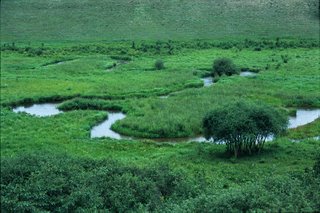
"Green Grow The Rushes, O" is an ancient ballad, possibly going back as far as the early Christians (it was originally sung in Hebrew), though it achieved most prominence in the British Isles. It served as the inspiration for R.E.M.'s track on their 1985 Fables of the Reconstruction (of the Fables, etc.), though R.E.M.'s "Green Grow the Rushes" has a typically gnomic lyric, possibly about Mexican immigration ("find some surplus, cheaper hands"), but who knows. I haven't listened to R.E.M. in ages, as I played the band to death during high school (my arty teenage girl friends considered the young Michael Stipe a heartthrob).
Louis Jordan's "The Green Grass Grows All Around," from 1941, is the happiest cumulative song you'll ever hear. Though I've no proof, I think "Green Grass" may have influenced the creepy "Maypole Song" chanted by the pagan children of Summerisle in The Wicker Man ("and on that tree there was a limb/and on that limb there was a nest" etc.) On the Tympany Five boxed set.
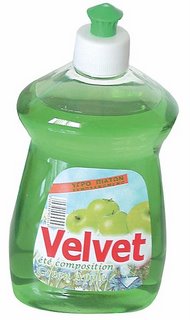
Rodgers and Hart's "Mountain Greenery" first appeared in 1925 in the show The Garrelick Gaieties (which also debuted "Manhattan"). Featuring one of Rodgers' sweetest melodies and Hart providing the sort of elegant rhymes that are close to becoming a lost art ("lover let"/"coverlet" being my favorite.) Rosemary Clooney's 1959 take is on Everything's Rosie!.
And at last, rock out with Bill Haley's "Green Tree Boogie", one of his first singles, from 1951. On Best Of.
Into the Green

Swamp Thing enters the Green
Love, meet me in the green glen,
Beside the tall elm-tree,
Where the sweetbriar smells so sweet agen;
There come with me.
Meet me in the green glen.
John Clare, Meet Me in the Green Glen.
Seeing green in excess, green upon green upon green, begins to wear on you. "A monotonous business," writes Alexander Theroux of green's dominance of nature. "Miles and miles of grass, grass, grass, trees, trees, trees, ad infinitum, a tableland of a single textile." Theroux's essay is once again a huge source of information for this entry.
The burgeoning nature of green can even cause queasiness. "See nature spuming and frothing...from the jammed glassy cells of sea roe to the feathery spores poured into the air from bursting green pods, nature is a festering hornet's nest of aggression and overkill," writes Camille Paglia in Sexual Personae.
The life forms of the great hothouse world lived out their days in ferocity or flight, pursuit or peace, before falling to the green and forming compost for the next generation.
From Brian Aldiss' Hothouse, from 1962, a novel set on Earth, millions of years into the future, when the sun is going nova and the earth has stopped its orbit, so that one side is frozen in darkness, and the other, the hothouse of the novel's title, consists of one enormous banyan tree, upon which the pathetic descendants of man, little green-skinned humanoids, are born, mate and die with the tenacity and transcience of mosquitoes.

Green's relentless vibrancy can mask a drive for death and conquest, like the Plants in Thomas Disch's The Genocides. The Plants are an alien crop infestation, which begin as lime-green sprouts and, in a week's time, grow to be 600 feet tall with leaves "the size of billboards." Or take the great Doctor Who serial The Seeds of Doom, in which the Doctor and Sarah Jane Smith face the Krynoid, an alien that can animate all plant life to turn against humanity, as well as the lunatic millionaire and herbophile Harrison Chase, who says of his greenhouse: "Welcome to my green cathedral!"

"Everything's Gone Green", in which New Order's Bernard Sumner seems to be falling into the green and getting subsumed by its rhythms, is from 1982. Find on Substance.
A cool color
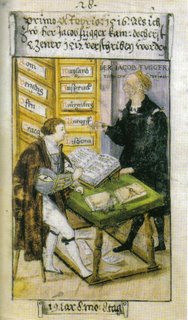
Jacob Fugger in His Office (ca. 1530), in which Fugger, the merchant, uses a green desktop.
Green is pleasing to the eye. The medieval bishop William of Auvergne believed that was because green sat at the center of the spectrum, between black and white, and thus the eye need neither constrict nor dilate to look at it. The surface of writing desks are often green because of this belief, as are proofreaders' green eyeshades. A 1514 health manual called Tregement der Ghesontheyt (Treatment of health) recommended staring into a green basin filled with water as a way to strengthen the eyes.
Green rooms, where actors go before or during performances, may have once been painted green to provide a relief from the stage lights. And one of the reasons surgeons and nurses wear green or green-blue scrubs is that the color better reflects the harsh white lamps in the operating theatre (plus, blood doesn't look as gruesome on a green shirt).

Card Players, follower of Lucas Van Leyden (ca. 1520).
And while ease on the eyes is one reason billiard, snooker and card tables generally have green baize coverings, such tables are also green to emphasize the mutability of luck, and the randomness of fortune ("the outcome on such a surface was never certain", Pleij). Above and below are two examples of green card tables.
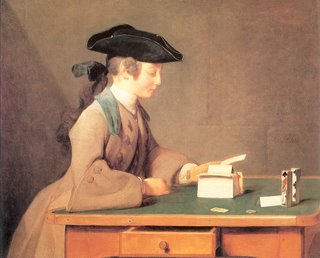
Chardin, House of Cards, 1736-37.
You could say green is a tonic for the soul. Central Park at its full vernal peak is the release valve for many New Yorkers, especially in the humid, vile summers--and in winter, you also can find solace in the pinetum on the northwest corner of the Great Lawn.
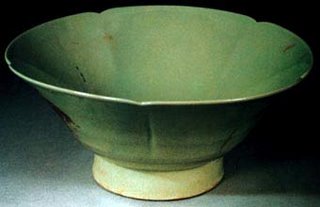
And the emperors of the Tang Dynasty prized, above all their treasures, a type of porcelain known as mi se, which has "a fading, autumnal green" color, more brown than emerald in hue. Victoria Finlay, in Color, takes her guess why: "Imagine you are an emperor, dusted with gold, surrounded by silks, held high on palanquins...Would you not then yearn for something earthy and real? [Mi se]'s blandness, to a sated appetite, would have been like a sorbet to the glutted palate."
Hope and home
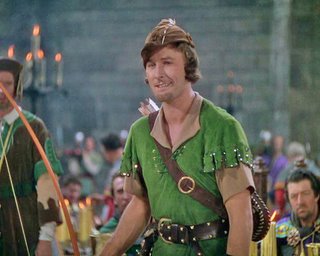
Errol Flynn in Lincoln Green
By malison of theirs is not so lost
Eternal Love, that it cannot return,
So long as hope has anything of green.
Dante, Purgatorio, Canto III.
Green is hope, it accentuates the positive--it is the color of the light telling you to hit the gas, of a stock rising in value, of the signs on the highway indicating where to go. Green bowls and cannisters are said to counter the effects of any poisonous items stored in them--the oldest piece of porcelain in the British Isles, the property of Archbishop William Warham and, latterly, New College, Oxford, is a celadon cup, seaweed-colored, which some believe was given to Warham, a diplomat during a very dangerous era--he was a contemporary of Machiavelli!--as a form of protection. (Sort of like giving Condi Rice a flak jacket).
Joy is a fruit Americans eat green.
Armando Zegri, The Golden Book.
It is the color of the light that symbolizes all Jay Gatsby yearns for. One of the most vivid images from Fitzgerald's novel has Nick Carraway spying how Gatsby "stretched out his arms toward the dark water in a curious way, and far as I was from him I could have sworn he was trembling. Involuntarily I glanced seaward--and distinguished nothing except a single green light, minute and far away, that might have been the end of a dock."
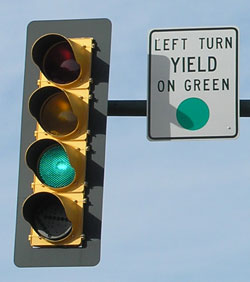
"The Light is Always Green" is a forgotten but lovely tune by the Housemartins, a pop Marxist/Christian band from the mid-1980s, led by Paul Heaton, who had one of the finest voices of his era. On 1987's The People Who Grinned Themselves to Death.
Most of all, green represents home, regardless of whether yours was a farm or tenement. Three odes to green homecomings:
Porter Wagoner's "Green, Green Grass of Home," from 1965, finds the singer coming home after a spell in prison, and the simple shade of green that he sees everywhere is both a reassurance and a mocking reminder of what he's lost. And then he wakes up. On Essential Porter Wagoner.
Or CCR's "Green River", in which John Fogerty sums up an edenic rural childhood in one pungent phrase: "barefoot girl/dancin' in the moonlight." The guitar riff's pretty great too. On 1969's Green River.
And the Kinks' "Village Green," from 1968, in which green becomes the embodiment for a whole set of lost verities. On Village Green Preservation Society.
I don't like diamonds;
the emerald's 'grass-lamp glow' is better;
and unobtrusiveness is dazzling,
upon occasion...
Marianne Moore, Voracities and Verities Sometimes Are Interacting.
'The fecundity of life and love'
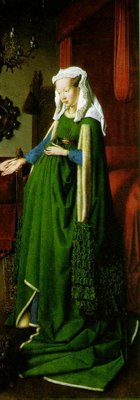
Van Eyck, The Arnolfini Marriage (detail), 1434.
And here the seedlings had been set to breeding
Their small green tedium of need:
Each plant alike, each plaintively devouring...
James Merrill, The Greenhouse.
Not surprisingly, green is often linked with reproduction, with pregnancy and birth, whether plant or animal. "If I had ovulated, [the stick] would be green, the color of life and eggs and sugar fluid," wrote Sylvia Plath in a 1959 letter, after failing a pregnancy test.
Green is the color of newborn spring, of the month of May ("so green, so green, so green!" wrote Thomas Dekker), and it seethes with fecundity. Andrew Marvell, in The Mower Against Gardens, refers to a "green seraglio." The 12th Century abbot/philosopher Hugh of St. Victor wrote a praise to green: "How it enraptures the minds of those who behold it, when new buds come forth in a new spring, and, rising like little darts, as if treading down death, burst into the light, an image of future resurrection."

Then in the early morning
Long before Dawn time
Your lover will lie in the paddock.
Between his fingers the green blades
And the green blades pressed against his body.
Katherine Mansfield, The Earth-Child in the Grass.

Bronzino, Portrait of a Lady in Green, 1530.
Not only the green of birth, but of conception. As Sappho, in her finest lust poem, says: "My tongue sticks to my dry mouth/thin fire spreads beneath my skin...chill sweat slides down my body/ I shake, I turn greener than grass." And giving a girl a "green gown" (aka, a roll in the hay) was a standard lyric in English folk songs. As Robert Herrick wrote in "Corinna's Going a-Maying", one of the standard "we're all going to die soon, so sleep with me" poems popular in the 17th Century.
Many a green-gown's been given
Many a kiss, both odd and even...
The blade of youth
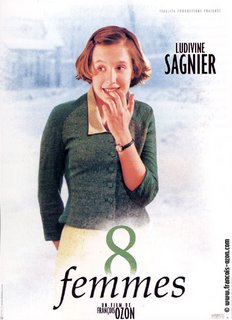
Green is also youth (think of Joni Mitchell's "Little Green") and inexperience. Green tea is unfermented tea leaves, greenware is pottery before it is baked. Shakespeare's works are filled with green youth, from Cleopatra's lamenting of her salad days, to Bertram in All's Well that End's Well, who has acted on "natural rebellion, done i' th' blade of youth", the blade being green grass. And green saturates Romeo and Juliet, "his greenest play" (Theroux)--in which the "envious" moon is "sick and green" in comparison with Juliet, who in turn is called "green-sickness carrion" by her enraged father.
Petrarch, in poem 30 of the Rime Sparse, writes of seeing "a youthful lady under a green laurel" whose image remains in his mind during the years that follow. "Then my thoughts will come to shore/when green leaves are no longer to be found on a laurel."
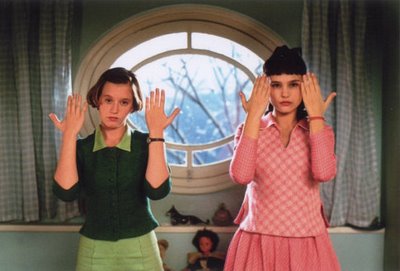
The young often are shown wearing green, such as Ludivine Sagnier, who dons green for much of Ozon's 8 Femmes. (Is there a loopier, more charming scene in recent film than Sagnier performing "Papa T'es Plus Dans Le Coup" in this movie? Or her and Virginie Ledoyen's dance routine to "Mon Amour Mon Ami"?)
The sound of green youth: in the early 1970s, Sibylle Baier was having a dark spell when her friend asked her to take a road trip to Strasbourg. The trip rejuvenated young Sibylle, and when she returned home, she began writing songs: "Colour Green" was one of them. Find Baier's home recordings on Colour Green, which was released last year by Orange Twin.
Green Dreams

He was describing, as all young poets are forever describing, nature, and in order to match the shade of green precisely he looked (and here he showed more audacity than most) at the thing itself, which happened to be a laurel bush growing beneath the window. After that, of course, he could write no more. Green in nature is one thing; green in literature another.
Virginia Woolf, Orlando.
Despite its commonplace appeal, green can be mystical, unnerving at times. Duke Ellington, for one, hated the color and never wore it: "He was a city boy. Green was like grass, and grass reminded him of graves," said Duke's biographer, Derek Jewell.
Green eyes are often signs of the supernatural, or of exceptional ability, or simply danger ("All that is not equal to the poison which flows/From your eyes, from your green eyes," Baudelaire, "Le Poison"). Rasputin had green eyes, as did Becky Sharp, Ichabod Crane, Thomas Gray's poor drowned cat, Ted Williams, Samuel Beckett and Sharbat Gula, the Afghanistani woman immortalized on National Geographic's 1984 cover (below). And in Joyce's "An Encounter," from Dubliners, a pair of boys encounter a shabby pervert who, as the narrator describes, had "a pair of bottle green eyes peering at me from under a twitching forehead."
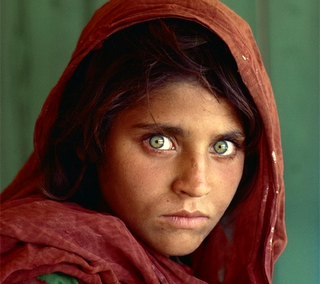
"Green Eyes", from Husker Du's 1985 Flip Your Wig, is one of their prettiest songs. And "Green Eyed Lady," Sugarloaf's one-hit wonder from 1970, can be found here.

There's a man trying to sleep but, some paces away, stands a great green door, behind which he hears sounds of a party--people laughing, a piano banging, horns, shrieks. He stares at the door, wondering what it could open into--a casino? A private sex club? He knocks, and no one responds; he knocks again and says he has an invitation--the door opens a crack. "Joe sent me!" the man yelps. And there's a thick laugh and slam! the green door is closed again.
Jim Lowe's "Green Door" is from 1956. A gift from the Rev. Frost, currently enjoying a well-needed vacation. Find it on the asininely-titled Great Men of Rock & Roll.
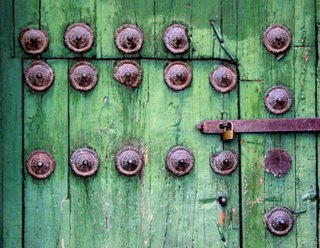
And then there's Esquerita's (or Eskew Reeder's) version, from 1962, which distills the question down to a couple phrases and lets the organ take care of the rest. It's of my favorite records: this is rock and roll--accept no substitutes. This version is a bit hard to find--one place is here.
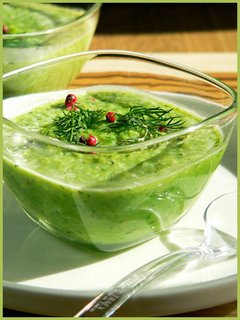
Although red is considered the color of revolution, green has had its own incendiary past. During the English Civil War, Oliver Cromwell's troops wore green ribbons, and Anthony Ashley Cooper, the tormenter of Charles II and founder of the Whigs, worked and plotted at the Green Ribbon Club. And Carlyle, in the French Revolution, described Robespierre as a "sea green incorruptible."
But like some revolutions, green can fade into corruption--it is the color of army fatigues worn by liberators-turned-dictators (a friend of mine had a rule of thumb--if your country is being run by a guy who wears military gear everywhere, it's time to get out). Elvis Costello's "Green Shirt," from 1979, refers to the seductive sheen of a newscaster's blouse, but is it also an army uniform? Are they the same? "Green Shirt" is from Armed Forces, originally titled "Emotional Fascism."

And green is, of course, the color of money. The Weems String Band, a family band from Perry County, Tennessee, made only one recording, on December 9, 1927, but what a testament: their take on the traditional "Greenback Dollar" just rips and roars. On the wonderful collection Down in the Basement, a compilation of vintage 78s collected by Joe Bussard and put out by Old Hat Records.
"Just a little piece of paper/coated with chlorophyll." Ray Charles's "Greenbacks", from 1954, is on Ultimate Hits.
Greensleeves
Is green finite? After all, if it is the color of spring and birth, winter and death would seem likely to fade it away. But green is not just youth and growth, but suggests permanence as well. Whenever green withers, there is the assurance it will revive someday. Listen to King Henry VIII, poet:
Green groweth the holly, so doth the ivy.
Though winter blasts blow never so high,
Green groweth the holly.
As the holly groweth green
And never changeth hue,
So I am, and ever hath been,
Unto my lady true.
Henry VIII, according to legend, is the author of "Greensleeves" as well, having composed it when he was courting Anne Boleyn. It is a pledge of constancy to an unconstant lover, a lyric made sickly ironic when the cold facts of history--of Henry and Anne's doomed union, her execution, his ceaseless marrying--are impressed upon it.
Ah, Greensleeves, now farewell, adieu,
To God I pray to prosper thee,
For I am still thy lover true,
Come once again and love me.
"Greensleeves", as if carried on the wind, prospered and transformed over the centuries, lending its melody to Gustav Holst and Ralph Vaughan Williams, to the Christmas carol "What Child Is This" and the Mister Softee ice cream trucks, among a host of others.
And one night, in New York, in late 1961, John Coltrane takes a breath on the stage of the Village Vanguard. A hush, then Reggie Workman, McCoy Tyner and Elvin Jones begin, entering in staggered perfection. Then comes Trane--he first lets the melody quietly unfold, stately and restrained, until Jones rumbles behind him, and then, as if nudged, Coltrane soars upward. For a handful of minutes, the North Carolina-born Coltrane and his partners take the Tudor king's song and work marvels with it. On the essential The Complete 1961 Village Vanguard Recordings.
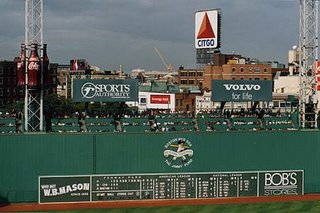
The Green Monster
Cover star: Sandy Denny.
Next:
O coward conscience, how dost thou afflict me!
The lights burn blue. It is now dead midnight.
Cold fearful drops stand on my trembling flesh.
No comments:
Post a Comment